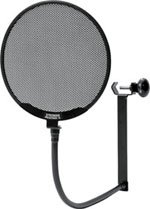Pop Filters
Pop Filters let people who come to your studio know that you mean business.
In addition to looking really sweet they do serve a useful role.
It's literally a physical barrier that is positioned in front of the microphone to eliminate "plosive" sounds during vocal recording.
What in the devil is a "plosive sound"?!?
Basically letters such as p, t, f, and k can cause a blast of air when leaving your lips to strike the diaphragm of your microphone.
Now your microphone is very carefully designed to intentionally detect changes in air pressure (usually associated with actual music) and so it doesn't know the difference.
We, however, can tell the difference and it does not sound good when these stray blasts of air get recorded to your track.
So in addition to keeping stray air blasts at bay, they can also keep spittle from getting into the mic itself.

Hygiene aside, you want to keep moisture out of the mics so that they continue to function properly as the years roll by.
Although the microphone frame may be rugged, the elements inside are delicate as a fresh lily and therefore need to be treated as such.
A quality pop filter is made of metal mesh that actually redirects the air away from the mic, whereas a cheaper option has one or more layers of nylon stretched over a frame.
Both accomplish the same thing, so don't worry too much about which type is available to you.
Finally, a mechanical snake arm attaches to the mic stand.
This is also a place where spending a little more can save some frustration.
You want it to stay put while you are trying to lay down your killer vocals.
A budget pop filter may have poor or no adjustment at all, while a more expensive option will have a sturdy neck that can be positioned precisely.
Though these are especially useful if, like me, you have terrible mic technique, you can get by without one if you are careful about your mic setup and positioning.
Backing away from the mic, not singing directly into it, putting it off-axis from the vocalist, etc. can also serve the same purpose.
It's certainly not essential, but I've found it to be useful when recording vocals in my own experience.
Just remember it's not a license to kill proper mic technique!









